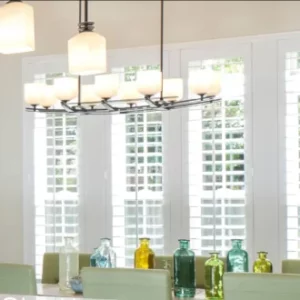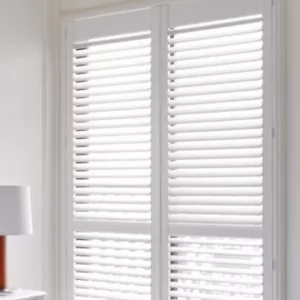Come and visit us at our new showroom: 1226 N Roselle Road Schaumburg, IL 60195
Shutters
Plantation Shutters
-
An iconic choice with renowned durability, strength and density. Resists peeling, cracking, chipping and yellowing. No wonder it’s #1 among the world’s homeowners. Plantation Shutters is more stable, robust and stronger than solid wood shutters.





Wood Shutters
-
Sophisticated and unique, with real hardwood’s unmistakable natural beauty and luxury. The Paulownia hardwood in Marqi Blinds stained shutters offers luxurious wood graining with elegant natural characteristics exhibiting both depth and character.



Interior Shutters
Marqi Blinds – Interior Shades is a wood composite hybrid shutter utilizing light weight yet durable ABS for its louvers, a material often used in high-end endurance applications such as appliances, car parts and helmets, while utilizing structured wood composite frames and rails. It is VOC safe and CARB compliant for off-gassing.


Composite Shutters
Marqi Blinds Composite Shutters let you experience the essence of real wood in rooms that require a durable or cost-effective solution.Engineered to withstand high humidity, Marqi Blinds Composite Shutters coordinate with Marqi Blinds Composite Blinds and are ideal for kitchens, laundry rooms, bathrooms, and other high-humidity rooms.






What are Shutters?
Shutters are sturdy window coverings made of horizontal slats that can be adjusted to control light, privacy, and airflow. They can be mounted inside or outside of windows and made from various materials such as wood, vinyl, or composite. Shutters add architectural detail to a home, enhance energy efficiency by providing insulation, and increase property value due to their durability and aesthetic appeal.
What are The Types of Shutters?
Exploring the different types of shutters can dramatically transform the appearance and functionality of your windows. Shutters offer privacy and control over the amount of natural light entering a room and contribute significantly to your home’s aesthetic and energy efficiency. From traditional wooden designs to modern composite materials, the variety available allows homeowners to select shutters that perfectly complement their home’s architecture and interior design. 8 types of shutters are listed below to help you find the perfect match for your living spaces:
- Plantation Shutters
- Wood Shutters
- Interior Shutters
- Composite Shutters
- Cafe Shutters
- Full-Height Shutters
- Tier-on-Tier Shutters
- Solid Shutters
Plantation Shutters
Plantation shutters are window coverings characterized by their wide louvers or slats, typically ranging from 2.5 to 4.5 inches (6.35 to 11.43 cm ) in width. They are designed to allow for adjustable light, offer privacy, and enhance ventilation while adding an elegant, architectural look to interiors. Originating in the American South, plantation shutters are suited for traditional and contemporary home styles, providing a timeless aesthetic. They can be crafted from various wood and composite materials to fit different decor preferences and functional needs.
Wood Shutters
Wood shutters are made from natural wood and are valued for their durability, classic appearance, and the warm, inviting ambiance they add to a space. They can be customized through various stains and finishes to match any interior decor style. Wood shutters offer excellent insulation, light control, and privacy, making them a popular choice for homeowners looking for a blend of functionality and aesthetic appeal in their window treatments.
Interior Shutters
Interior shutters, designed for inside use, offer privacy, light control, and a decorative touch to any room. They’re mounted on the inside of windows and feature adjustable louvers for versatile light management. Made from various materials, including wood and composite, interior shutters enhance the room’s aesthetic while providing functionality.
Composite Shutters
Composite shutters are made from engineered materials that offer the look and feel of real wood but with superior durability and resistance to moisture and warping. They are ideal for areas with high humidity or direct contact with water, such as bathrooms and kitchens. Composite shutters are also low maintenance, easy to clean, and provide excellent insulation, making them a practical choice for both aesthetic and functional purposes in home decor.
Cafe Shutters
Cafe shutters, also known as half-height shutters, cover only the bottom of a window. They offer a balance of privacy and natural light, allowing light to enter through the top half of the window while providing seclusion where it’s most needed. This style is perfect for kitchens and dining areas with desired light and privacy. Cafe shutters add a charming European aesthetic to any space, making them a popular choice for those looking to enhance their home decor with a functional yet stylish window treatment.
Full-Height Shutters
Full-height shutters are window coverings that span the entire window height, providing complete coverage. They offer optimal privacy and light control, making them suitable for any room in the home. Their seamless design enhances traditional and contemporary interiors, improving insulation and energy efficiency.
Tier-on-Tier Shutters
Tier-on-tier shutters consist of two independent sections of shutters, one on top of the other, providing versatile light control and privacy. This design allows the top and bottom shutters to be opened or closed independently, offering flexibility to adjust for sunlight and visibility. They are ideal for street-facing windows where control over privacy and light is essential, combining functionality with aesthetic appeal to complement a wide range of interior designs.
Solid Shutters
Solid shutters are made from panels without louvers or slats, offering complete window coverage. They provide excellent insulation, total darkness, and maximum privacy. Solid shutters are ideal for bedrooms and traditional homes and add a classic, elegant touch to interiors while enhancing security.
How to Choose the Right Shutters?
Choosing the right shutters for your home involves considering functional and aesthetic factors to enhance your living space. Shutters offer privacy and light control and contribute significantly to your home’s curb appeal. Here are key points to keep in mind:
- Assess Your Needs: Determine your priorities—privacy, light control, energy efficiency, or aesthetics. Your primary need will guide your choice.
- Material Matters: From wood to composite materials, each offers different benefits regarding durability, appearance, and maintenance.
- Style and Design: Choose a shutter style that complements your home’s architecture. Plantation, cafe, and full-height shutters each provide a distinct look and feel.
- Color Coordination: Select colors that match or complement your existing decor. Neutral tones offer versatility, while bold colors make a statement.
- Measurements and Fit: Proper measurement is crucial for shutters to look their best and function properly. Consider hiring a professional for precise measurements and installation.
- Maintenance Requirements: Consider how much time and effort you will dedicate to maintaining your shutters. Some materials require more care than others.
- Professional Consultation: Don’t hesitate to consult with a professional. They can offer valuable advice on what works best for your needs and home layout.
- Budget: Set a realistic budget. While shutters are an investment in your home, options are available at various price points to meet your financial plan.
By carefully evaluating these factors, you can select shutters that meet your practical needs and enhance your home’s beauty and value.
What is The Cost of The Shutters?
The cost of shutters can vary widely based on several factors, including material, size, customizations, and installation charges. We listed a general overview below:
- Material: Wood shutters are typically more expensive than those made from vinyl or composite materials. For example, hardwood shutters might start at around $70 to $350 per square foot, while vinyl and composite shutters can range from $20 to $100 per square foot.
- Size and Quantity: Larger windows and greater numbers of windows will increase the overall cost. Custom sizes and shapes can also add to the expense.
- Customization: Custom color matching, unusual shapes, or special hardware options can increase costs.
- Brand and Quality: Premium brands and higher quality materials come with higher price tags but often offer better durability and aesthetics.
- Installation: Professional installation costs can vary by region and complexity of the installation, typically ranging from $100 to $300 per window.
- Geographic Location: Prices can also vary depending on where you live due to differences in labor costs, shipping fees, and local market conditions.
To get a more accurate estimate, it’s best to consult with a few local suppliers or installers who can provide quotes based on your specific needs and preferences.
What are The Benefits of Shutters in Interior Design?
Shutters are window coverings that provide a versatile addition to any interior design scheme. Their timeless appeal and practical benefits make them a popular choice for homeowners looking to enhance the style and functionality of their spaces. Here are some key benefits listed below:
- Enhanced Aesthetic Appeal: Shutters add a touch of elegance and sophistication to any room, complementing modern and traditional décor.
- Increased Property Value: Quality shutters can increase the market value of your home, making it more attractive to potential buyers.
- Improved Energy Efficiency: Shutters provide excellent insulation, keeping your home warmer in winter and cooler in summer, which can help reduce energy bills.
- Optimal Light Control: Shutters with adjustable slats allow precise control over the light entering a room, from bright and airy to softly dim.
- Enhanced Privacy: Shutters offer privacy without sacrificing natural light, as you can adjust the slats to block views from outside while still letting light in.
- Low Maintenance: Unlike other window treatments, shutters are easy to clean and maintain, requiring only a quick wipe-down to keep them looking their best.
- Durability: High-quality shutters are built to last, resisting wear and tear better than many other window treatments, making them a cost-effective long-term solution.
- Noise Reduction: Shutters can help reduce external noise, creating a quieter and more comfortable indoor environment.
Tips for Matching Shutters with House Decor
Matching shutters with house decor and other window treatments is important for achieving a cohesive and stylish look in your home. Consider the following tips to ensure your shutters complement your interior design:
- Assess Your Decor Style: Determine the overall style of your home decor, whether it’s modern, traditional, rustic, or eclectic. Choose shutters that align with this aesthetic.
- Consider Color and Finish: Select shutter colors and finishes that harmonize with your room’s existing color palette. Opt for neutral tones for a versatile and timeless appeal or bold colors for a statement look.
- Think About Material: Choose shutter materials that match the vibe of your space. Wood shutters lend warmth and texture, while vinyl or composite shutters offer durability and easy maintenance.
- Coordinate with Window Trim: Pay attention to the color and style of your window trim when selecting shutters. Ensure they complement each other to create a cohesive appearance.
- Factor in Light and Privacy: Determine the light control and privacy level you need in each room. Louvered shutters offer adjustable light and privacy settings, while solid shutters provide maximum privacy and light blockage.
- Consider Room Functionality: Consider each room’s function when choosing shutters. For example, moisture-resistant materials are ideal for bathrooms, while energy-efficient options may be suitable for living areas.
- Match Hardware and Accessories: Coordinate the hardware and accessories of your shutters with other elements in the room, such as door handles, light fixtures, and furniture hardware.
- Layer with Curtains or Drapes: Enhance the aesthetic appeal of your windows by layering shutters with curtains or drapes. Choose complementary fabrics and colors to create depth and visual interest.
- Seek Inspiration: Find inspiration from interior design magazines, websites, or social media platforms to discover creative ways to incorporate shutters into your decor scheme.
- Customize if Needed: If standard shutter options don’t quite fit your vision, consider customizing them to match your specific design preferences and requirements.
By following these tips, you can ensure that your shutters seamlessly integrate into your house decor, adding style and functionality to your living spaces.
Custom Shutters
When it comes to enhancing your home’s aesthetic and functionality, custom shutters offer a versatile solution tailored to your unique preferences and requirements. With a wide range of customization options, you can create a personalized look that seamlessly complements your interior decor. Whether you prefer traditional or contemporary styles, custom shutters provide endless possibilities to elevate the beauty and comfort of your living space.
- Tailored to fit your windows perfectly
- Personalized design options to match your style
- Wide range of materials, finishes, and colors available
- Ability to accommodate non-standard window shapes
- Offers flexibility and versatility in design
- Quality craftsmanship ensures durability and longevity
- Enhances the overall aesthetic of your home
- Customizable features to meet your functional needs
- Adds value to your property with a unique and tailored look
- Professional installation ensures a seamless finish
How to Install The Shutters
Installing shutters is a straightforward process that can be accomplished with basic tools and patience. Here’s a step-by-step guide to help you install your shutters effectively:
- Gather Your Tools: Before you begin, make sure you have all the necessary tools on hand, including a drill, screws, measuring tape, level, and a pencil.
- Measure Your Windows: Start by measuring the width and height of your windows accurately. This will ensure that your shutters fit perfectly once installed.
- Mark Mounting Points: Using a pencil and level, mark the mounting points on the window frame or wall where you’ll attach the shutter brackets. Make sure these points are aligned and evenly spaced.
- Install Mounting Brackets: Using your drill and screws, attach the mounting brackets to the marked points on the window frame or wall. Ensure that the brackets are securely fastened to support the shutters properly.
- Hang the Shutters: Once the brackets are in place, carefully lift the shutters and align them with the mounting brackets. Slide the shutter hinges into the brackets and ensure they snap securely into place.
- Secure the Shutters: Once the shutters are hung, use screws to secure them to the mounting brackets. Make sure the shutters are level and properly aligned before tightening the screws.
- Test for Smooth Operation: Open and close the shutters several times to ensure they operate smoothly and without obstructions. Make any necessary adjustments to the hinges or mounting brackets as needed.
- Final Checks: Once the shutters are installed, double-check that they are securely attached and operate correctly. Clean any fingerprints or smudges from the shutters to complete the installation process.
- Follow Instructions: Follow the manufacturer’s instructions for the best results and prevent accidents and damages.
- Seek Professional Help: Ask for professional help when you need complicated processes to protect your walls, windows, and blinds.
By following these steps, you can install your shutters confidently and enjoy the enhanced beauty and functionality they bring to your home. If you encounter any difficulties during the installation process, don’t hesitate to seek assistance from a professional installer.
How to Care of Your Shutters?
Caring for your shutters is essential to ensure they remain in good condition and continue to enhance the beauty of your home. Here are listed quick tips for maintaining and caring for your shutters:
- Regular Dusting: Use a soft, dry cloth or a feather duster to remove dust and debris from the surface of your shutters. Regular dusting will help prevent buildup and keep your shutters looking clean and fresh.
- Spot Cleaning: For stubborn stains or spots, use a damp cloth or sponge with mild soap and water to wipe the affected areas gently. Avoid using harsh chemicals or abrasive cleaners, as they may damage the finish of your shutters.
- Avoid Excess Moisture: Shutters are generally moisture-resistant, but excessive moisture can still cause warping or damage, especially for wooden shutters. Avoid spraying water directly onto the shutters, and ensure that any spills or splashes are promptly wiped dry.
- Lubricate Moving Parts: If your shutters have hinges or other moving parts, lubricate them periodically with a silicone-based lubricant to ensure smooth operation. This will help prevent squeaking and ensure your shutters open and close easily.
- Inspect for Damage: Regularly inspect your shutters for any signs of damage, such as cracks, chips, or loose components. Address any issues promptly to prevent further damage and ensure the longevity of your shutters.
- Protect from Sun Damage: Direct sunlight can cause fading and damage to the finish of your shutters over time. Consider installing UV-protective film on your windows or using curtains or blinds to block harsh sunlight and protect your shutters from sun damage.
- Professional Maintenance: If your shutters require more extensive cleaning or repairs, consider hiring a professional shutter cleaning service. They have the expertise and specialized tools to clean and maintain your shutters effectively without causing damage.
Following these care tips, you can keep your shutters looking beautiful and functioning smoothly for years. Regular maintenance and care will not only prolong the life of your shutters but also enhance the overall appearance of your home.



